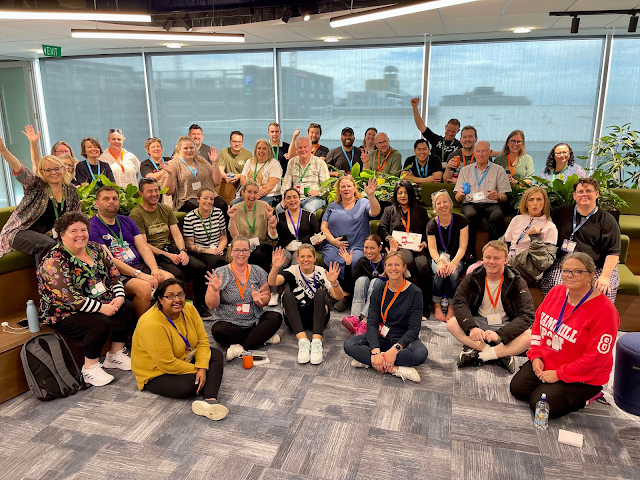I am not a number
Last month, I attended the National hui for our countries Microsoft Innovative Educator Experts (MIE Experts) in Auckland. Apart from the excitement of meeting fellow educators face to face again after the tribulations of COVID, it was also a time to reflect on what we had learnt from the pandemic.
One of those reflections was from Australian educator and part time ukulele player Pip Cleaves who asked the question why do we need grades? Variability in our students is the norm, yet we do not build upon this uniqueness. Instead, we teach to the average and manage expectations. But as number six in one of my favorite series while growing up, the Prisoner would say:
I am not a number; I am a free man!
So why do we define our students by the grades they get? and what could be an alternative? Take Tim. Tim is a boy in my junior science class. He is a very sweet and caring boy; he is always the boy when a new student comes into the class, he immediately includes them. He is the boy who thanks me at the end of every lesson. He also loves his Minecraft he can sit all during lunch time with intense focus on building Minecraft worlds with confidence and independence. However, when I read his report, he is a failure by the measure of grades.
Although he is caring and curious, he is not assessed on those qualities. What was measured from reading to speaking and listening did not as point out in Pip's keynote create a holistic account of his strengths and areas for improvement.
So how can we start to move from a grade-based model to one that builds on the strengths and goals of each student? As I am teaching in a New Zealand classroom, being culturally responsive involves developing relationships that are founded upon Māori idea of rangatiratanga, or self-determination. This involves evolving the relationships in the classroom in a way that students can become independent and contribute to the learning from a position of independence, rather than from a position of dependence. This could be one mechanism to make this transition.
The concept of rangatiratanga involves the teacher to position themselves to support the developing independence of the student. Teachers have an important role to play in students’ self-determination, which means allowing students to be themselves, to be different, and to participate in learning and in education in unique and personal ways. Such support for self-determination requires classroom relations based on interdependence, rather than relations based on hierarchy. This enables students to participate and engage in their education on their own terms, and at the same time enable teachers to better understand the world of their students.
When interactions and relations are built on interdependence, the class becomes similar to a whānau (family), in which students and teachers communicate ideas and construct common understandings and meanings. These whānau-type interactions make students and the teacher responsible for the learning and care of other members of the class, with actions and behaviors guided by the philosophy of the class. The focus is on connectedness, relations and involvement with others in order to promote self-determination for all.
Conversations with parents, showed that grades were only one part of what success means for them and their children. Other important aspects of educational success also included finding purpose and fulfillment in life.
With the grade-based approach, we tend to view each student through a deficit mindset - they do not know something. We need to change the lens to one of understanding and building on their unique strengths to help build those strengths and assist them in developing skills and knowledge in areas where they are not yet strong.
One approach that can incorporate rangatiratanga is the use of learner profiles like those used in International Baccalaureate, such profiles extend what success can look like and give a more holistic view of the student. One does need to be careful though and not again just focus on academics. By connecting the profile with what the student is doing through key competencies, we expand what educational success is and can create opportunities, content and skills for students to attain that success.
If we feel these competencies are important, then we need to acknowledge that they have value.
When moving away from grades we can focus more on the process of learning over the product. Digital portfolios using tools like Wakelet, for example when students are working on a term science project with finding an aim, hypothesis development, data collection, conclusions and discussions, I can sit down with students to discuss how they are exhibiting the learner profile. This can be showing evidence of growth and mastery and defend conclusions they have made with evidence - key scientific competencies.
Mastery is not the same as success. Success happens at fixed point in time, mastery is not just a goal but the constant pursuit to improve, a process not a product. Success is a grade; mastery is becoming a better scientist and citizen.
This also removes one of the major failures of the grade system - reducing the complexity of learning to a letter or number. This approach shows to the students the growth in learning they have experienced over the year. By gathering student learning evidence to measure progress it highlights to the student what they can do and also provides multiple means of representation of the learning occurring in the classroom.
Finally, students can share their evidence of learning and show their development in key concepts and skills over time. It is also an effective way for students to develop skills to communicate data as well!
The movement from grades is a choice. A choice to focus on the learner and learning first and foremost and to celebrate the unique individuals that our students are and are developing into through cultivating the unique geniuses and talents our students have.








Comments